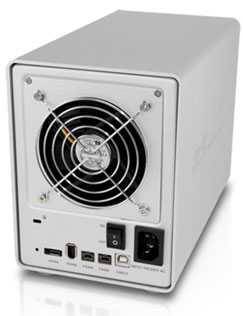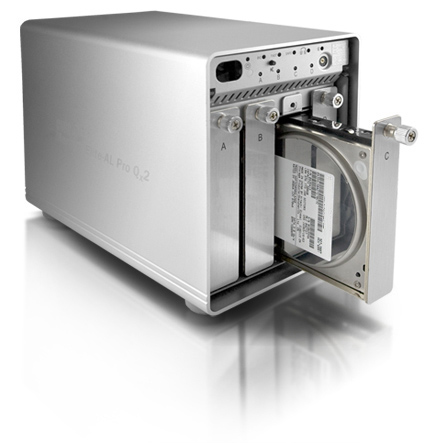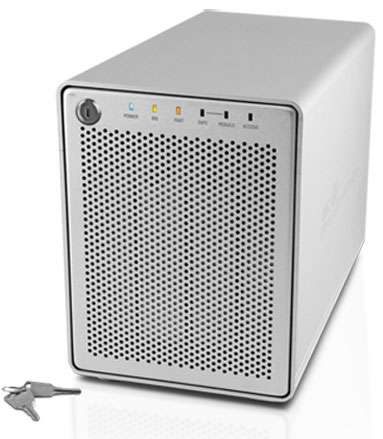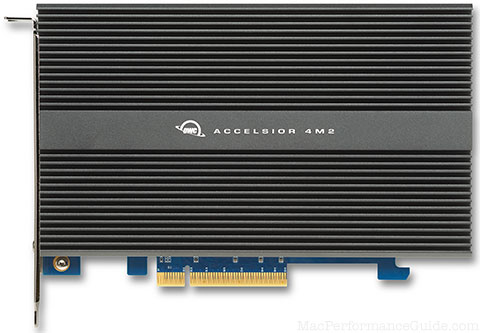
|

|

|

|

|

$220 SAVE $130 = 37.0% Western Digital 16.0TB Western Digital Ultrastar DC HC550 3.5-in… in Storage: Hard Drives
|

|

|

|

|
OWC Mercury Elite Al-PRO QX2
Related: diglloydTools, DiskTester, eSATA, hard drive, laptop, Mac Pro, MacBook, MacBook Pro, Other World Computing, RAID, RAID-0, storage, USB
The Other World Computing Mercury Elite-AL Pro QX2 is a 4-bay drive enclosure supporting a variety of RAID options without any add-on hardware; the functionality is built into the QX2 itself via an Oxford 936 “quad interface” chipset.
The QX2 accepts up to four (4) SATA hard drives. It can be used with fewer drives, but simpler solutions exist for 1 or 2 drives, so plan on using at least three drives. As of mid 2011, the QX2 provides up to 12TB of storage (9TB as RAID-5) using four 3TB hard drives.
Why use the QX2? PERMALINK
The QX2 is a great choice for fast, high capacity and reliable storage, offering built-in redundancy/reliability features via RAID 1, RAID 5 or RAID 10. While Mac Pro users can and should use the internal drive bays for storage, the QX2 is for those cases where more storage and/or hardware RAID functionality is desired.
You can choose highest capacity and performance (RAID 0 striping), or highest reliability (RAID 1 mirroring) or a blend eg RAID 5 striping + parity or RAID 10 striping + mirroring. Options depend on the number of drives installed, see details.
The QX2 attaches to any Mac with no special hardware required, but for maximum performance an eSATA card is required (Mac Pro or some MacBook Pro models). See details.
Enterprise option PERMALINK

For mission-critical use, be sure to get the QX2 as an enterprise offering.
See details here on the outstanding 5-year parts/3 years labor, rapid-replacement and data recovery features for the enterprise option.
Use of enterprise-grade drives backed up by priority service is a no-brainer for some users— your data is what your business depends on.
Other World Computing notes (updated November 19, 2009) PERMALINK
When you buy a non-empty QX2, OWC “burns in” the unit (as of November 2009)! Obviously, no burn-in test can be done without hard drives installed, which makes it a good idea to order the QX with the hard drives pre-installed, instead of installing your own into an empty QX2.
External solutions from most vendors are assembled, then shipped with little or no testing, which means that you are the one doing the testing. A multi-hour burn-in is a huge value-add, because it means that you can count on a unit (and drives) that have been proven to work under extreme load for several hours.
This is what OWC has to say about it.
ALL solutions 2TB to 8TB are now pre-tested for no less than 4 hours prior to ship out. The DiskTester fill-volume command is used to put them under continuous load for an extended period of time (to no less than 40-50%, usually to 100% if we’re ahead without backorders). This ensures units are operating properly and that the drives installed are solid. Drive failures are pretty rare, but this additional testing – beyond just loading 2GB of data – eliminates DOA drive issues pretty much entirely. Same service is performed to our Rack solutions.
Support
Just about every computer product I’ve used has had issues, especially as new computer models are introduced, but a reliable vendor acknowledges issues and take steps to fix any that arise. This note from OWC clearly their commitment to quality and customer support (hyperlink added for clarity):
The QX2 is now ‘re-qualified’ for the use with the NewerTech eSATA extender cable. All units shipped since August 22nd are supported. We are doing a pro-active replacement program for all units pre-August 22nd (that we haven’t replaced already – relatively low number) that will cover those customers for this (firmware related) and also eliminate ANY possibility of a alarm/power issue we’ve seen in some of these earlier units. No data loss has resulted from the issue, but we’re about having first class products out there and we want all customers to have no compromise with quality and reliability.
Performance and reliability — RAID 5 PERMALINK
The QX2 supports a variety of RAID options.
The RAID 5 option (striping + parity) is the most attractive option, because it offers the ideal combination of high performance along with safety: one drive can fail with no data loss. A failed drive can be replaced, and the QX2 automatically rebuilds the parity information with no user intervention beyond replacing the failed drive. Use of RAID 5 requires at least three drives, but use four drives to keep speed and capacity maximized. Alternately, 3 drives can be active, with one drive as a “hot spare”.
The QX2 attaches to any Mac with no special hardware required, but for maximum performance an eSATA connection is required (Mac Pro or some MacBook Pro models).
Connecting the QX2: Firewire, USB and eSATA PERMALINK
Mac Pro or some MacBook Pro models can connect the QX2 via eSATA, which offers high performance. A single eSATA cable connects the QX2 and offers speeds in the 180-250MB/sec range, depending on configuration. By comparison, Firewire 800 will never exceed ~83MB/sec, and is typically much slower, especially for writes.
You can add an eSATA card to a Mac Pro, or some models of the MacBook Pro via the ExpressCard slot. Of course, you can start out using Firewire 800, then add eSATA later (if your Mac supports doing so).
You can also connect the QX2 with Firewire 800, Firewire 400 or USB 2.0. Of those, Firewire 800 is the fastest way to achieve mediocre performance. Firewire 800 is for use with dead-end Macs which cannot use eSATA. If your Mac is one of those, then Firewire 800 is your best choice. It’s as good as it gets without eSATA.
Which drives in the QX2? PERMALINK
The QX2 accepts 1, 2, 3 or 4 standard SATA drives, but it makes little sense to use a 4-bay unit with 1 or 2 drives. With RAID 5, one of the drives is required for parity (redundant information).
Your smart move is four identical hard drives (same brand, model, capacity). Three drives is also OK, see table below for details.
The QX2 is available empty, or with hard drives pre-installed. Hard drives are screwed into the 4 metal brackets using a phillips screwdriver; this takes a minute or two per drive. Remove the faceplate, attach the brackets to the drives, then insert the drives into the enclosure.
While drives mismatched in capacity or brand or model can be used, the effective size of each drive is the size of the smallest capacity drive used. Performance or other glitches could occur using mismatched drives; one flaky drive is just not worth it — stick to matched drives if possible.
If all you want to do is install one or two older hard drives in an an enclosure then get something simpler like the OWC Mercury Elite single or dual drive units.
High capacity, high-performance fault-tolerant storage for photography and video.
Non-RAID or RAID-0/1/4/5/10.
Capacities up to 72 Terabytes!
RAID Options
The table below summarizes the various RAID options.
| RAID Options for 1/2/3/4 drives | ||
|---|---|---|
| Number of drives | Options | Comments |
| 1 | Single volume, no RAID | Pointless, get a single-drive enclosure |
| 2 | RAID 0 (stripe) RAID 1 (mirror) Spanning |
Works fine, but a more compact 2-bay enclosure can do the same job. |
| 3 | RAID 0 (stripe) RAID 1 (mirror) RAID 5 (striping + parity) Spanning |
You’re almost there, get 4 drives and do it right. However, any of the RAID 0/1/5 options work well with 3 drives. |
| 4 | RAID 0 (stripe) RAID 1 (mirror) RAID 5 (striping + parity) RAID 10 (striping + mirroring) Spanning |
RAID 5 is most attractive, tolerating one drive failure. RAID 10 allows offers somewhat higher reliability (failure of one drive from each mirrored pair).. Spanning is the least attractive of all, forget it. |
Storage capacity using 2TB drives PERMALINK
I recommend the Hitachi Deskstar 7K2000 2TB for use with the QX2; I tested the QX2 extensively with four of them in various RAID modes. Other Hitachi drives are also a good choice, such as the E7K1000 “Saturn”.
Using 2TB hard drives, various levels of performance are available. Cut the capacity in half for 1TB drives.
| Capacity Using 1/2/3/4 Drives and RAID 0/1/5/10 | ||||
|---|---|---|---|---|
| Number of drives | RAID 0 (striping) | RAID 1 (mirroring) |
RAID 5 (striping + parity) |
RAID 10 (striping + mirroring) |
| 2 X 2TB | 4TB | 2TB | n/a | n/a |
| 3 X 2TB | 6TB | 2TB | 4TB | n/a |
| 4 X 2TB | 8TB | 2TB | 6TB | 4TB |
| 4 X 3TB | 12TB | 3TB | 9TB | 6TB |
Build quality PERMALINK
Build quality is impressive—no plastic or cheap stuff here. The all-aluminum case is not only rock-solid, but attractive.
The heavy-duty rubber feet minimize vibration. The power supply is internal, so there is no power brick to deal with, a plus. The status and display lights are well done and informative. A locking key can be used to deny access to the drives (leave the key inserted for convenience if opportunistic theft is not a risk).
The oversize fan is about as quiet as one can expect from a 4-drive enclosure (the drives themselves contribute most of the noise). The fan makes an innocuous sound (no odd pitches which could annoy).
There is ample air space between the drives— important for drive health and longevity, and the front cover is fully perforated to allow airflow across all four drives evenly. Checking the drives after 17 hours of continuous use, they remained nicely cool.
Installing drives is quick and easy, requiring only a phillips screwdriver.
Simulating drive failure PERMALINK
The idea of RAID 5 is to tolerate failure of one drive.
I simulated failure by pulling one drive with tasks in progress. The QX2 continued to operate without a hitch*. Also, I used my not-yet-released IntegrityChecker program to verify bit-for-bit data integrity (SHA1 cryptographic hashes). In short, the QX2 performed flawlessly.
With the “failed” drive missing, performance remained high; I observed 240MB/sec on reads while verifying file integrity, an excellent performance.
I also simulated failure in RAID 10 mode, pulling one drive from each of the two mirrors (two drives total). The QX2 continued to operate without data loss.
* The Sonnet Tempo E4P eSATA card requires driver version 2.2.0 to operate correctly with the Oxford 936 chipset used by the QX2 (the volume will unmount when a drive fails with earlier firmware). Reinserting the drive still has a problem with the E4P (no data loss, requires reboot), but the QX2 rebuilt the RAID without a hitch. Other eSATA cards might behave differently.
Performance PERMALINK
Performance was tested primarily with eSATA; Firewire 400 or USB 2 are too slow to be of any use. Firewire 800 is OK if you have no other option.
The Sonnet E4P was used for the eSATA card, and four Hitachi Deskstar 7K2000 2TB drives were used. Mac OS X 10.6.1 was used with a 32-bit kernel, because as of this writing the Sonnet E4P card does not have a 64-bit driver.
RAID Test modes
The QX2 was tested with RAID 0 (striping), RAID 5 (striping + parity) and RAID 10 (striping + mirroring). It operated flawlessly in all modes, with excellent performance.
Limitations of one eSATA cable
The QX2 uses a single eSATA cable, which limits top speed to ~250MB/sec, similar to that of any port-multiplied enclosure. In this case, use of one cable is not only convenient, but allows all the RAID options without also requiring a more advanced eSATA card.
Users that require speeds in the 400-500MB/sec range can use dual QX2 enclosures, or an enclosure that uses multiple eSATA cables and/or SAS or mini-SAS connectors (along with a suitable eSATA card in the Mac Pro). The vast majority of users will find speed in the 200MB/sec range quite refreshing, and that’s still considerably faster than Firewire 800.
Using eSATA on the MacBook Pro via the ExpressCard/34 slot offers very good performance, but not as fast as on the Mac Pro.
Firewire 800 performance — it all depends on volume size PERMALINK
Firewire 800 is a a mediocre option, but it’s the best option if eSATA cannot be used. It should be able to deliver ~80MB/sec, but in practice a poor implementation on Macs often yields write speeds that are only in the 40-50MB/sec range, especially on volumes larger than 1TB.
For highest speed with Firewire 800, create volumes that do not exceed 1TB by partitioning the drive (QX2). Performance rises dramatically!
Using RAID 5 mode with a 6TB volume, I observed speeds of 47MB/sec for writes, and 68MB/sec for reads. Disappointing, but still far superior to the Drobo.
Using RAID 5 mode with a 1TB volume (partition), I observed speeds of 73.9MB/sec for writes, and 85.7MB/sec for reads.
These numbers show just how sad the state of affairs is with Firewire 800 on the Mac. Perhaps Apple will fix this bug in the future. It was supposed to be fixed in Snow Leopard, but this has not yet happened as of 10.6.1.
DiskTester fill-volume — RAID 5
This DiskTester fill-volume test took 17.6 hours to complete on the ~6TB RAID 5 volume (4 X 2TB drives in RAID 5). Firewire was not tested this way, because it would have taken about 3 days to complete.
Average write speed across the entire ~6TB capacity was 165MB/sec, average read speed was 198MB/sec. For most users, these numbers will be more than adequate, and very welcome. Note however, that with the drives used here, read and write averages would exceed 400MB/sec as a RAID 0 stripe internal to a Mac Pro, or in a suitable external enclosure: double the performance but subject to failure of any single drive unless a special RAID card is used in the Mac Pro.
RAID 5 (striping + parity) is somewhat slower on writes than reads, presumably because of the need to calculate the parity data. Performance is reasonably consistent, which is important for some users. Consistency might be better with enterprise-grade drives; the Hitachis 2TB models used here were not the enterprise A7K2000 model.
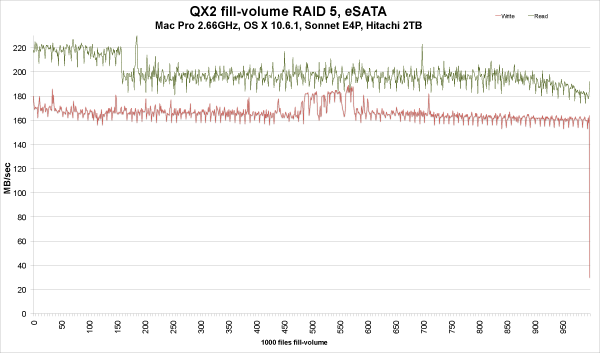
DiskTester run-area-test — RAID 0 stripe
The DiskTester run-area-test command was used for a quick overview of entire-volume performance.
With the QX2 in RAID 0 stripe mode, I achieved outstanding read speeds (for an enclosure using only one eSATA cable). Write speeds were very fast, but significantly lower than read speeds.
disktester run-area-test --iterations 3 --test-size 4G --chunk-size 32M qx2
--- Averages for "qx2" (4GB/32MB, 3 iterations) ---
Area (7.27TB) Write MB/sec Read MB/sec
0% 185 255
10% 195 255
20% 194 257
30% 193 249
40% 195 255
50% 197 256
60% 196 248
70% 198 255
80% 197 256
90% 178 257
100% 199 240
Average write speed across the volume: 193MB/sec
Average read speed across the volume: 253MB/sec
DiskTester run-area-test — RAID 10 stripe + mirror
The DiskTester run-area-test command was used for a quick overview of entire-volume performance.
RAID 10 is striping + mirroring, which allows one drive to fail, and possibly two (depending on which one). Capacity is halved eg four 2TB drives produce a 4TB volume.
Performance does drop across the volume as one would expect (drive speed).
disktester run-area-test --iterations 3 --test-size 4G --chunk-size 32M qx2
--- Averages for "qx2" (4GB/32MB, 3 iterations) --- Area (3.61TB) Write MB/sec Read MB/sec 0% 190 240 10% 155 245 20% 192 238 30% 194 229 40% 190 220 50% 197 211 60% 182 195 70% 164 187 80% 160 169 90% 140 151 100% 118 124 Average write speed across the volume: 171MB/sec Average read speed across the volume: 201MB/sec
Conclusions and recommendations PERMALINK
The OWC QX2 is a reliable and cost-effective option for anyone seeking high performance storage with the reliability of RAID 5 or RAID 10. Solidly built, it’s a bargain in the land of RAID, where hardware can quickly become expensive.
The QX2 supports other RAID options such as striping or mirroring or spanning, but RAID 5 should be the first choice for most users, because it provides high performance while tolerating the failure of one drive.
Be sure to use eSATA with the QX2, but if you use Firewire 800, see the performance notes.
The Hitachi Deskstar 7K3000 3TB is my first choice for use with the QX2, but lower-capacity drives will be equally at home in it, with similar performance. Just be sure to use four matched drives for optimal performance and capacity. A fifth drive kept on hand as a spare is worthwhile so that any drive failure can be immediately dealt with.
Getting one
Click below to view a shopping cart with various options (choose one capacity/model of hard drive, not all of them!). A 5th drive is recommended as an on-hand replacement in case of drive failure.
View an OWC shopping cart with the QX2 and various drive and eSATA options.
You can buy an empty QX2 and install your own drives, or get one with the drives pre-installed; this comes at a slightly higher price, but also with a longer all-inclusive warranty.View all the QX2 models.
Seagate 22TB IronWolf Pro 7200 rpm SATA III 3.5" Internal NAS HDD (CMR)
SAVE $100

 diglloydTools™
diglloydTools™

